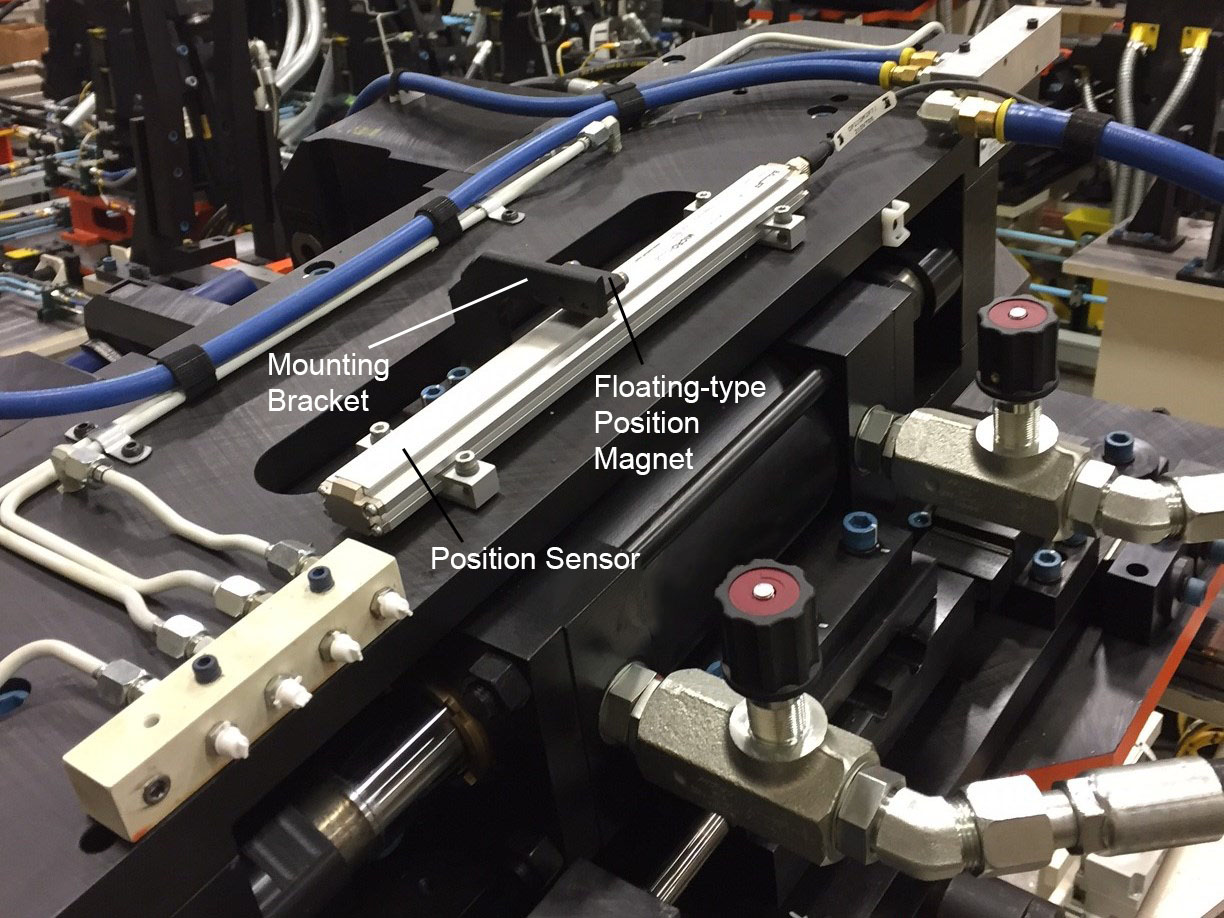The classic linear position feedback solution for hydraulic cylinders is the rod-style magnetostrictive sensor installed from the back end of the cylinder. The cylinder rod is gun-drilled to accept the length of the sensor probe, and a target magnet is installed on the face of the piston. A hydraulic port on the end cap provides installation access to thread in the pressure-rated sensor tube. This type of installation carries several advantages but also some potential disadvantages depending on the application.

(Image credit: Cowan Dynamics)
Advantages of in-cylinder sensor mounting include:
- Simplicity. The cylinder manufacturer “preps” the cylinder for the sensor and may install it as an extra-cost option.
- Ruggedness. The sensor element is protected inside the cylinder. Only the electronics head is exposed to the rigors of the industrial environment.
- Compactness. The sensor is contained inside the cylinder, so it does not add to the cross-sectional area occupied by the cylinder.
- Direct Position Measurement. Because the target magnet is mounted on the piston, the sensor is directly monitoring the motion of the cylinder without any interposing linkages that might introduce some position error, especially in highly dynamic, high-acceleration / deceleration applications.
Potential disadvantages of in-cylinder sensor mounting may include:
- Sensor Cost. Cylinder-mounted position sensors require a rugged, fully-sealed stainless-steel sensor probe to withstand the dynamic pressures inside a cylinder. This adds some manufacturing cost.
- Cylinder Cost. The procedure of gun-drilling a cylinder rod consumes machine time and depletes tooling, adding manufacturing cost over a standard cylinder. Refer to additional comments under Small Cylinder Bores / Rods below.
- Cylinder Delivery Time. Prepping a new cylinder for a sensor adds manufacturing time due to additional processing steps, some of which may be outsourced by the cylinder manufacturer, increasing overall shipping and handling time.
- Overall Installed Length. Because the sensor electronics and cabling protrude from the back end of the cylinder, this adds to the overall length of the installed cylinder. Refer to additional comments under Small Cylinder Bores / Rods below.
- Service Access. In case sensor repair is required, there must be sufficient clearance or access behind the cylinder to pull out the full length of the sensor probe.
- Small Cylinder Bores / Rods. Some cylinder bores and rod diameters are too small to allow for gun-drilling a hole large enough to install the ~10.2 mm diameter sensor tube and allow for proper fluid flow around it. In tie rod cylinders, the distance between the rod nuts may be too small to allow the flange of the position sensor to fully seat against the O-ring. In these cases, a mounting boss must be provided to move the mounting position back past the tie rods. This adds cost as well as increases overall installed length.

In cases where the advantages of in-cylinder mounting are outweighed or rendered impractical by some of the disadvantages, an externally-mounted position sensor can be considered. The list of advantages and disadvantages looks similar, but reversed.

Advantages of external sensor mounting include:
- Sensor Cost. Externally-mounted magnetostrictive position sensors are typically made from an aluminum extrusion and die-cast end caps with gaskets, saving cost compared to all-stainless-steel welded and pressure-rated construction.
- Cylinder Cost. The cylinder can be a standard type with no special machining work needed to accommodate installation of the sensor.
- Cylinder Delivery Time. Since no additional machine work is needed, the cylinder manufacturer can deliver within their standard lead time for standard cylinders.
- Overall Installed Length. Typically, the external sensor is mounted in parallel to the cylinder, so overall length is not increased.
- Service Access. The externally-mounted sensor is easily accessible for service by simply unbolting its mounting brackets and pulling it off the equipment.
Disadvantages of external sensor mounting may include:
- Complexity. The machine designer or end user must provide the means to mount the sensor brackets and the means to position a floating magnet target over the sensor housing. Alternatively, a captive sliding magnet target may be used with a length of operating rod and swivel attachment hardware.
- Exposure to Damage. Unless guarded or installed in a protected area, an externally mounted position sensor is subject to being mechanically damaged.
- Space Requirements. There must be enough empty space around the cylinder or on the machine to accommodate the sensor housing and operating envelope of the moving magnetic target.
- Indirect Position Measurement. Any time a floating target magnet is mounted to a bracket, there is the potential for position error due to the bracket getting bent, flexing under acceleration / deceleration, mounting bolts loosening, etc. In the case of operating rods for captive sliding magnets, there will be some mechanical take-up in the swivel joints upon change of direction, adding to position hysteresis. There is also the potential for rod flexing under heavy acceleration / deceleration – particularly when the rod is acting under compression vs. tension. Take note of the amount of sliding friction of the captive magnet on the sensor rails; some sensor magnet designs offer high friction and stiff resistance to movement that can increase operating rod deflection and resultant position error.
In conclusion, be sure to consider all aspects of an application requiring cylinder position feedback and choose the approach that maximizes the most important advantages and eliminates or minimizes any potential disadvantages. It may be that an externally-mounted position sensor will solve some of the challenges being faced with implementing a traditional in-cylinder application.
For more information about internally- and externally-mounted cylinder position sensors, visit www.balluff.com.

